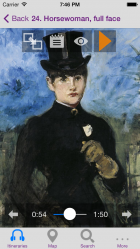
The tenth of October 1992 was a great day for Spanish cultural life and, in particular, for the city of Madrid. The Thyssen-Bornemisza Museum was to open its doors following complex negotiations and several years of building work on the Palacio de Villahermosa. This 18th-century mansion was refurbished by the prestigious Spanish architect Rafael Moneo, who was to design the extension to the Prado Museum some years later. The new museum was not a competitor of the Prado, but instead a magnificent complement to it.
The purpose of the new Madrid art gallery was to house the collection of old masters and modern artworks gathered together by the Thyssen-Bornemisza family over seven decades. This magnificent collection of works was begun by Baron Heinrich and expanded by his son, Hans Heinrich. The two Barons thus built up one of the most outstanding art collections in the history of painting.
In 1988, the Spanish government concluded a loan agreement. A few months after the museum opened, in June 1993, this agreement became a permanent loan to the Spanish State. The negotiations were certainly handled with great diplomacy, to which the interest of the King and Queen, Don Juan Carlos and Doña Sofia, the good work of the King’s sister and brother-in-law, the Duke and Duchess of Badajoz, and the key figure in the agreement, Baroness Thyssen, all contributed. Years later, in 2002, the Baroness’s private collection was added, on deposit, to the museum’s holdings, enhancing the collection of works on display.
The Villahermosa Palace, where the museum is housed, is an enormous Neo-classical mansion whose greatest strength was its location, right opposite the Prado Museum and close to the Reina Sofia contemporary art museum, thus completing one of the most important triangles of art galleries in the world. The architect Moneo did a wonderful job of redesigning the building around a well-lit central roofed courtyard
The permanent collection is on show on three floors, arranged in chronological order. On the right side of the ground floor, temporary exhibitions are on display. These often occupy the basement floor as well, which means that two exhibitions can be held at once. The ground floor also contains a lovely shop and a pleasant cafeteria where visitors can stop and rest.
The small garden at the entrance is presided by a bust of Baron von Thyssen, a reminder that it is to him we owe the fact that the museum is located here in Madrid.
In the lobby we can admire a huge canvas by Tintoretto depicting Glory, and some sculptures by the French sculptor Rodin, a great friend of the Baron’s father, who advised him on his art acquisitions. The hall’s decoration is completed by four portraits by Macarrón: two show the King and Queen of Spain, and two more portray an elegant Baron and Baroness Thyssen.
(c) (R) 2013, MUSMon com S.L.
Text (a) Catalina Serrano Romero
Pictures
Source: Wikimedia Commons
Author: Luis García (Zaqarbal)
Permission: GNU Free Documentation License, Version 1.2 or any later version published by the Free Software Foundation
Independently produced by MUSMon.com, the audio guide for the Thyssen-Bornemisza Museum offers you a wide-ranging, light-hearted and educational tour of one of Spain’s most outstanding art museums. It contains 90 minutes of commentary, illustrated with over 52 high-quality images, so you won’t miss a single detail during your visit.
We will guide you on your journey through the history of painting. +info




































































